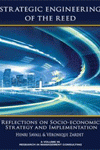
Strategic Engineering of the Reed
Reflections on Socio-Economic Strategy and Implementation
By:
Henri Savall, ISEOR and Jean Moulin University
Veronique Zardet, ISEOR and Jean Moulin University
A volume in the series: Research in Management Consulting. Editor(s): David Brian Szabla, Western Michigan University.
Published 2017
This volume is part of an ongoing partnership between the Research in Management Consulting book series and the Socio-Economic Institute for Firms and Organizations (ISEOR), located in Ecully, France, on the outskirts of Lyon. The socio-economic approach to management (SEAM) provides a pathway to creating more engaged, more responsible and responsive, and more productive organizations. In many respects this volume reflects a culmination of ISEOR’s work, drawing together Henri Savall and Veronique Zardet’s insights and framing them in the context of strategy creation and, just as if not more important, strategy implementation.
This volume casts SEAM in the context of strategy development and implementation. Reflecting on the changing nature of work and the workplace, the potential power of—and need to develop and build on—human potential has never been greater. Savall and Zardet have always thought that the Western concept of human resources was misguided, that people are not a resource to use up but rather a source of potential to invest in, develop, and nurture. People bring their potential to the organizations in which they work—and it is their choice as to whether they will apply it in their jobs. Thus, a core managerial challenge is to create an environment in which that potential can be maximized.
SEAM-based strategy builds on this premise, developing an approach to economic and social performance, providing direction as to how managers can create and implement strategies that enhance organizational effectiveness and efficiency. As Savall and Zardet argue, strategic vision does not have to be limited by constraints in the external environment—companies “are not compelled to enter in a ‘strategic’ tunnel” that mimics the competition and the market. Instead, companies can experience breakthroughs, turning constraints into opportunities by unleashing their internal energy, power, and cohesion, working and succeeding as a team. The SEAM approach to strategy is grounded in innovation and creation far more than imitation—and, as convincingly illustrated in the volume, that creativity can be self-financed through the value-added created by the elimination of organizational dysfunctions and the hidden costs they generate. The volume provides an insightful guide for enhancing economic and social performance, with a useful mixture of specific tools and techniques—grounded in a conceptual view of organizational life—interspersed throughout that illustrate how it can be done.
CONTENTS
Preface - Anthony F. Buono. Foreword - Serge Pasquier. Introduction. Framing the SEAM Methodology. PART I: RENEWAL OF STRATEGIC ANALYSIS AND DECISION. PART II: THE SOCIO-ECONOMIC STRATEGY CONCEPT. PART III: THE STRATEGY LITMUS TEST: IMPLEMENTATION, ASSESSMENT, ADJUSTMENT. Appendix I: History of the Socio-Economic Strategy Concept. Appendix II: Socio-Economic Strategy of Companies. Appendix III: Assessment Scale of the Socio-Economic (SEAM). Strategy Criteria. References. About the Authors.
-
Paperback9781681239514
Web price: $45.04 (Reg. 52.99)
-
Hardcover9781681239521
Web price: $80.74 (Reg. 94.99)
- eBook9781681239538

- BUS041000 - BUSINESS & ECONOMICS: Management
- BUS069000 - BUSINESS & ECONOMICS: ECONOMICS: General
- BUS055000 - BUSINESS & ECONOMICS: Reference
-
 Consultation for Organizational Change Revisited
Consultation for Organizational Change Revisited
-
 Digital Transformation
Organizational Challenges and Management Transformation Methods
Digital Transformation
Organizational Challenges and Management Transformation Methods
-
 Facilitating the Socio-Economic Approach to Management
Results of the First SEAM Conference in North America
Facilitating the Socio-Economic Approach to Management
Results of the First SEAM Conference in North America
-
 Intervention Research
From Conceptualization to Publication
Intervention Research
From Conceptualization to Publication
-
 La Recherche-Intervention Dans les Entreprises et les Organisations
La Recherche-Intervention Dans les Entreprises et les Organisations
-
 Management Consulting in the Era of the Digital Organization
Management Consulting in the Era of the Digital Organization
-
 The Socio-Economic Approach to Management Revisited
The Evolving Nature of SEAM in the 21st Century
The Socio-Economic Approach to Management Revisited
The Evolving Nature of SEAM in the 21st Century

